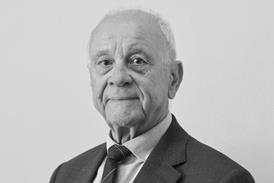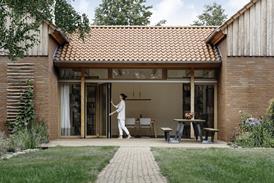In other words, buildings won't need waterproof roofs of their own any more because soaring above them and stretching for miles will be a giant umbrella that shields all a city's structures. Flat roofs really could be flat. Something like this is already happening at Kingsdale School, London.
Because Texlon (a close cousin of Teflon – see 'It came from outer space', facing page) is a plastic, it doesn't need the support other roofing materials do. One square metre weighs 200g, including the plastic piping that inflates the cushions. The same area of glazing weighs several kilos.
As a result, you can even dispense with trusses and suspend the roof from cables – a concept that cushion roof specialist Vector calls the Xanadome. The company is currently building a small Xanadome (20m by 30m) at Wallsgrave Hospital in Coventry and is discussing bigger versions with clients. Morris, the 46-year-old co-founder of Vector, claims that a Xanadome can free-span a kilometre.
But Texlon is more than just a high-tech cladding for futuristic one-offs like the Eden Centre's biomes. After serving the long apprenticeship that all innovations in construction have to undergo, Texlon has won cautious acceptance. It's cheap, too – Morris reckons it's half to two-thirds the cost of glazing a roof. And schools and hospitals have started to adopt it.
Airbag insulation
Cushion roofs consist of layers of Texlon welded together at the edges and inflated to make airbags. The air stops the plastic sheets flapping around and insulates the building below. The more airbags, the better the insulation. The typical U-value ranges from 2.94 for the single airbag created by a two-sheet roof to 1.18 for the four-airbag system of a five-layer roof.
At Kingsdale School in Gypsy Hill, London, Galliford Try project director Bob Collyer is covering a three-storey-high quadrangle the size of a football pitch with a three-layer cushion roof that automatically regulates its solar shading. Roofing the space let Collyer build a dining hall that seats 500 pupils, a walkway and a large auditorium with tiered seating, as well as a two-storey roofed structure with a library on the ground floor and a mini-auditorium on the first.
Sensors control solar shading by varying the degree of clash between the pixellating graphics on two of the Texlon sheets (see 'Sun screen', left). "The patterns graphically interfere with each other and make the roof look like a sparkly dress," says Morris. Collyer puts it more prosaically: "It's like an enormous great rooflight that controls the admission of natural light."
First, Collyer had to strengthen the 1960s-built school's existing steelwork to take the extra weight of the Texlon roof. He then spanned the 36m width of the quad with a series of curved steel trusses – Kingsdale is not a Xanadome – and covered the 6m-wide space between each with a single piece of Texlon. "It's thick, rigid stuff, like the canvas sides on lorries. Pulling it across was very heavy work," he says.
Miracle material?
Collyer reckons that Texlon is heavy-duty enough to walk on. Morris goes a bit further. He says you can bounce on it as you would a trampoline, although if you take him at his word you'll leave two little dents behind each time you land. "It won't tear even if you walk across it in stiletto heels," he says. "Five years back, kids heaved a paving stone onto one of our cushion roofs at a swimming pool reception in Scotland. It went through the top layer but the middle sheet held and the air in the lower compartment pushed it up to seal the hole in the top sheet. It's self-healing." Self-healing? Well, it stops the air escaping through tears. For a permanent repair, there's a roll of special tape.
According to Morris, Texlon is self-cleaning too and has got the graffiti artists licked. "It's got the second-best friction co-efficient known to man," he declares. "Grit and dust don't stick to it. A bit of rain will wash aerosol paint away." The supreme super-slippy champion? Teflon, of course.
Built-in safety
Collyer isn't quite so wide-eyed. He's used Texlon before, on a tented roof for a Butlins camp at Bognor Regis (of which he's very proud), and he says they needed abseilers to clear off the bird droppings.
For his final trick, Morris points out the miracle material's ability to disappear in a puff of smoke. Texlon doesn't catch fire: it's self-extinguishing. At 200 degrees C, Texlon just shrivels away from the heat source. Morris has exploited this by creating a cushion roof that self-destructs. Hot wires run around three sides of the cushions on a fail-on-demand roof; the hot wires, when activated, sever the cushion from the trusses it is attached to. The Texlon drops down, leaving the building without a roof.
"In a shopping mall, for example, a lot of the construction budget goes into dealing with fire," says Morris. "But this 'disappearing roof' takes up to 20% off build costs by turning an enclosed mall into an open street." In other words, because the roof will remove itself, the construction team doesn't have to conform to the stricter fire regulations demanded of internal spaces.
"These things never make money, but I love what you can do with it," says Morris. Beautiful buildings are his passion. "We choreograph the whole operation," he says.
Enquiry number 206
It came from outer space
Texlon emerged from America’s determination to win the space race. Back when Nasa’s goal was to put a man on the moon, chemical company Dupont invented fluoro-polymers, of which Teflon is the best-known example, as an electrical insulant impervious to cosmic radiation. In the 1980s, Vector added ethylene to create ethylene-tetra-fluoro-ethylene (ETFE), the chemical description for which Texlon is the brand name. Like its Teflon ancestor, ETFE will last forever. And not only is it eternal, the latest version from Vector’s R&D lab is virtually invisible. “Hold it up and you don’t know it’s there – you can’t see the edges,” says Morris. Although not so clear as glass, Texlon allows more light to pass through. Installations include the Eden Project, the Treasury, the National Gallery and Sainsburys head office. And with Wimbledon looking for a transparent roof to prevent days being rained off, Texlon may serve another ace.Sun screen
Both the upper and middle sheets of the Kingsdale roof are laid out in a chessboard pattern, with half the squares on each screening out UV light. With no air between the two sheets, the screening squares are offset, giving maximum solar shading. But as the upper airbag inflates, the screening squares overlap, decreasing the shading. Sensors automatically pump air from the lower to the upper airbag to raise the temperature.Future vision

Source
Construction Manager




















No comments yet